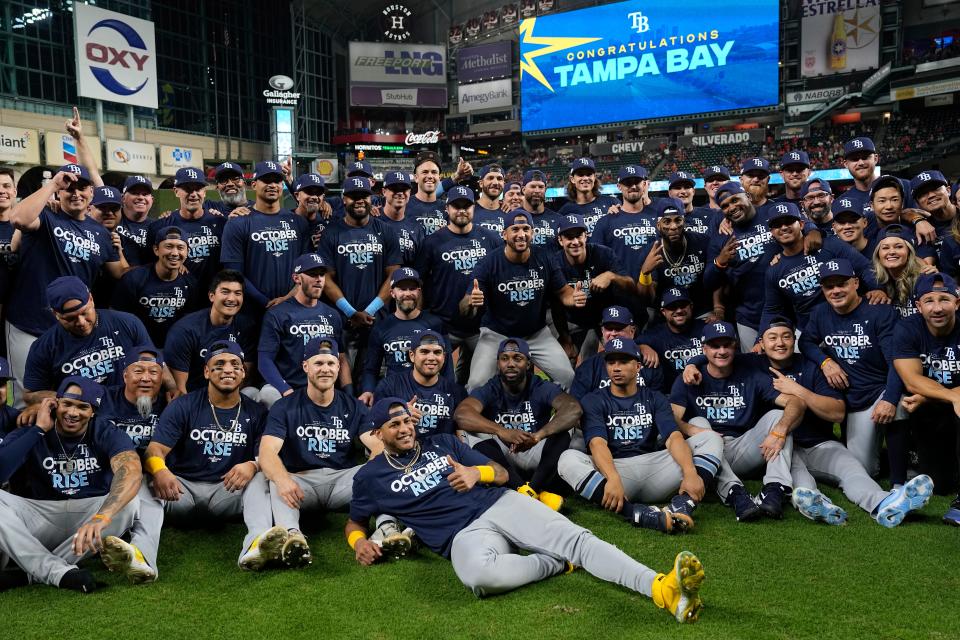Scanlon: Rays back in expanded postseason as long shots

This is what Major League Baseball had in mind by expanding the playoffs.
It keeps more teams in contention in the dog days of the regular season. Back in the days of pennant races, only two teams played in the postseason, and a few more took their hopes into the final weeks or days. The rest played out the string in August and September.
Now 12 teams make the playoffs. Anyone with a .500 record at the All-Star break is in contention. And, of course, anything can happen in the postseason. Now there is an established history of teams coming from the back of the pack and winning the World Series.
Atlanta did it just last year. The Braves had a losing record in early August, got hot, added the right pieces at the trade deadline, finished with the third-best record in the National League, stayed hot, and won it all.
The Washington Nationals might go down as the ultimate proof of the possibility of everything coming together for a magical moment. After being 37-40 in late June of 2019, the Nats rallied to qualify for a wild-card spot, then came back from a 3-1 deficit in the eighth inning to win the one-game wild card. The proceeded to knock off the Dodgers, sweep the Cardinals in the NLCS and win a seven-game World Series against the Astros. For about a month they were the best team in baseball. It unraveled quickly and three years later, they may be the worst team in baseball. Nevertheless, it did happen.
Everyone hated the one-game wild card and Major League Baseball was looking for an excuse to expand the postseason. So now we have three wild cards in each league and it will take at least two losses to eliminate them. In the wild-card round, the team with the better record gets to play the entire best-of-three series at home.
Rays manager Kevin Cash says it's a change for the better.
"I understand the time and travel constraints and you can't go back and forth between cities. I totally understand that," he said. "But one game -- that's really challenging, to put all your season into one game."
The only problem is the World Series, once known as the October Classic, is not likely to start until November. MLB has determined it can live with that as long as the additional dollars come with it.
The new format produced an unusual final month in the American League, where the Rays, Toronto Blue Jays and Seattle Mariners emerged as the likely wild cards several weeks ago, and none of them had a realistic shot at winning their divisions. September became a scramble among those three teams to claim the top wild card, and thereby play their first-round series at home.
"It's definitely a unique thing, especially with the three-game series as opposed to just a one-game wild card," said Toronto interim manager John Schneider. "It just adds to the importance of trying to win every series, and I think that's a good thing."
In this particular season, the playoff teams separated from the also-rans fairly early, with a few exceptions. Schneider described the three-team AL wild-card competition (Baltimore was officially eliminated last weekend) as MLB's attempt to "let all hell break loose for a couple weeks and see what happens."
Under last year's format, the three teams would have battled for two spots, and one of those survivors would have been eliminated in one game.
"I think it keeps a lot of teams engaged and it keeps a lot of teams competitive and I think it's good for baseball," Schneider said last week. "It's nice that we're playing these kind of games right now."

It worked even better in the NL, where the Braves and Mets didn't settle their division until the final weekend. The Mets, who once led the division by 10 1/2 games, will have to go the wild-card route, but at least they are in it.
Which brings us to the Rays, who are back in the postseason for a fourth straight year with a team that barely resembles the first three, or even the team that started this season. After losing Mike Zunino, Kevin Kiermaier and formidable relievers Andrew Kittredge and J.P. Feyereisen -- all early in the season -- the Rays were rebuilt on the run. They go into the postseason with a veteran lineup that includes left fielder David Peralta, center fielder Jose Siri and catcher Christian Bethancourt, none of whom were on the roster in July.
The Rays don't scare anybody on offense. They have to manufacture runs and keep pressure on defenses to have a chance. They are prone to collective slumps, and it goes without saying that their postseason will end quickly if they go into one of those.
Pitching depth has been the Rays' strength, and this year they added two good starters (Drew Rasmussen and Jeffrey Springs) while patching up the bullpen holes left open by injuries to Kittredge, Feyereisen, Ron Anderson and Ryan Thompson. With the recent return of Tyler Glasnow, the outlook for pitching depth next season looks better than ever.
Meanwhile there is this postseason. As explained above, it isn't such a bad thing to go into the postseason as an underdog, and the Rays have at least three very good signs going -- Glasnow and Wander Franco are healthy, and Randy Arozarena is hot. That makes them a better team than they were for most of the season.
This article originally appeared on The Ledger: Scanlon: Rays back in expanded postseason as long shots

